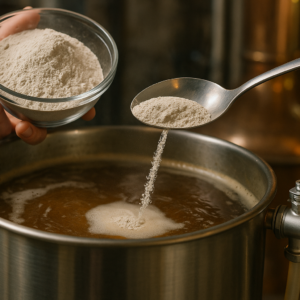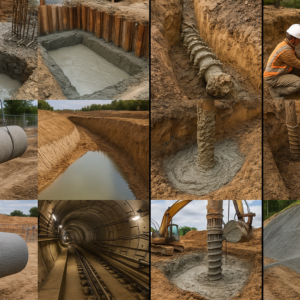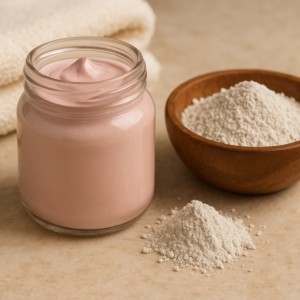If you’re dealing with a leaking pond, you’ve probably heard about bentonite as a solution. But what exactly is pond sealing bentonite, and why does it work so well? Let’s break it down.
Water loss from ponds can be frustrating and costly. Whether you’re managing a farm pond, decorative water feature, or aquaculture facility, excessive seepage means constant refilling and wasted resources. That’s where bentonite clay comes in as a natural, effective solution.
Understanding Pond Sealing Bentonite
Bentonite is a natural clay mineral formed from volcanic ash that settled millions of years ago. The most common type used for pond sealing is sodium bentonite, which has unique properties that make it perfect for stopping water leaks.
When sodium bentonite particles come into contact with water, they expand and fill gaps in the soil, forming a dense, waterproof layer. This natural swelling ability is what makes bentonite such a reliable pond sealant.
Think of it this way: dry bentonite looks like regular powdery clay. But add water, and something remarkable happens. The clay can expand as much as 15 times its original size, creating a gel-like barrier that plugs tiny holes and cracks in your pond bottom.
Why Ponds Leak in the First Place
Before we get into how bentonite fixes leaks, let’s talk about why ponds leak at all.
Most pond seepage problems come from porous soil. Sandy or gravelly soil contains countless tiny spaces between particles. Water naturally flows through these gaps, slowly draining your pond. Rocky soil creates similar issues, with water finding paths between stones and through fissures.
Even clay-based soil can develop problems over time. Natural settling, animal activity, root systems, and erosion all create channels for water to escape.
How Pond Sealing Bentonite Actually Works
The science behind bentonite is straightforward but clever. Sodium bentonite swells into pores in the soil, sealing those pores and preventing water flow.
Here’s what happens at a microscopic level:
When dry bentonite particles absorb moisture, the clay’s molecular structure changes. Water molecules get trapped between the clay layers, causing them to spread apart. This swelling process creates a gel-like mass that’s incredibly dense and impermeable.
The material swells up to 12 times its dry weight when it contacts water, filling in all those troublesome gaps. Once expanded, the bentonite forms a continuous barrier that water simply can’t penetrate easily.
The beauty of this system is that it’s self-sealing. If small cracks develop over time, any water that enters causes the bentonite to swell again, automatically plugging the new leak.
Three Main Methods for Applying Bentonite
Choosing the right application method depends on your pond’s condition and whether you can drain it. The blanket and mixed blanket methods work best when building a new pond or when you can drain and repair the water bed, while the sprinkle method seals leaks in ponds that can’t be drained.
The Blanket Method
This is the most reliable approach for new construction or major repairs. The blanket method involves spreading bentonite across the pond bed in a layer typically 1 to 4 inches thick, then covering it with a protective layer of soil.
The process works like this: Start with a clean, smooth pond bottom. Remove any rocks, roots, or debris. Spread the bentonite evenly across the entire surface. Cover the bentonite layer with 6 inches of soil to protect it and help compression happen properly.
This method gives you the best seal because the bentonite forms a continuous barrier across the entire pond bottom.
The Mixed Blanket Method
If your soil already contains some clay but still leaks, mixing bentonite into the existing soil can work well. Rather than removing soil, you rake or till the top 4 to 6 inches at the bottom of the pond, then apply bentonite to the surface and till it into the soil.
A typical mix ratio is 5 parts soil to 1 part bentonite, and after spreading the mixture, it should be compacted to minimize soil porosity.
This method uses less bentonite than the pure blanket approach, which can save money on larger ponds. The key is thorough mixing so the bentonite distributes evenly throughout the soil layer.
The Sprinkle Method
What if you can’t drain your pond? The sprinkle method lets you seal leaks while the pond stays filled. Bentonite granules are scattered over the water surface, where they sink and settle into cracks, holes, and crevices at the bottom, sealing off leaks.
This approach is less predictable than the blanket methods because you can’t control exactly where the bentonite settles. The bentonite sinks to the bottom and starts to expand in order to seal problematic areas under the pond.
The sprinkle method works best for small leaks or spot repairs rather than completely sealing a highly porous pond bottom.
Confused between sodium and calcium bentonite? Read this blog to find out which one is ideal for water well drilling!
How Much Bentonite Do You Need?
Application rates vary based on your soil type and how badly your pond leaks. Generally, you’ll need anywhere from 2 to 6 pounds per square foot of pond surface.
Sandy or gravelly soil needs more bentonite, often 4 to 6 pounds per square foot. Soil with some existing clay content might only need 2 to 3 pounds per square foot.
A simple calculation helps: measure your pond’s bottom area in square feet, then multiply by the recommended pounds per square foot for your soil type. Add 10% extra to account for uneven application.
For perspective, a small pond measuring 20 feet by 30 feet (600 square feet) with sandy soil might need between 2,400 and 3,600 pounds of bentonite at 4 to 6 pounds per square foot.
Timeline: When Will the Seal Take Effect?
Don’t expect instant results. Bentonite will not stop leaks immediately, and some seepage should be expected for up to 60 to 90 days after application.
The bentonite needs time to fully hydrate and expand. As it absorbs water, it gradually swells to fill all the tiny spaces in your pond bottom. The seal typically strengthens over the first few weeks as the clay continues to hydrate and compress.
You should notice a decrease in water loss within the first week or two, with the seal becoming fully effective after two to three months.
Benefits of Using Bentonite for Pond Sealing
Why choose bentonite over other sealing methods like synthetic liners? Several reasons:
Bentonite is 100% natural. It’s a mineral clay that won’t introduce chemicals into your water. This makes it safe for fish, plants, and livestock that drink from the pond.
The material is self-healing to a degree. Minor disturbances that might tear a synthetic liner simply get filled in again as the bentonite re-swells with water.
Bentonite is cost-effective, especially for larger ponds where synthetic liners become prohibitively expensive. The clay itself is relatively inexpensive, and application doesn’t require specialized equipment in most cases.
The seal is permanent if applied correctly. Unlike some treatments that need regular reapplication, a properly installed bentonite seal can last for decades.
Important Considerations and Best Practices
Proper application is critical so that bentonite is thoroughly mixed with compacted soil or in a uniform layer between compacted soil layers.
Temperature matters. Apply bentonite when the pond bottom is relatively dry but not completely parched. Some moisture helps, but standing water (except with the sprinkle method) can wash away bentonite before it sets.
Compaction is essential with the blanket and mixed blanket methods. Walk over the applied area or use light equipment to compress the soil and bentonite together. This forces the clay into soil pores and helps create a tight seal.
Protect the bentonite layer. Whether you’re using the blanket or mixed blanket method, cover the bentonite with soil to prevent disturbance. This protective layer also provides weight that helps compress the bentonite.
Fish should be removed before applying granulated bentonite to the water surface when using the sprinkle method, as the settling clay can temporarily affect water quality.
Common Mistakes to Avoid
Using too little bentonite is probably the most common error. Skimping on material means incomplete sealing. Calculate your needs carefully and buy enough to do the job right the first time.
Uneven application creates weak spots. Whether spreading dry bentonite or mixing it with soil, take time to distribute it uniformly. Thin spots will continue to leak.
Applying bentonite to wet, muddy soil (for blanket methods) reduces effectiveness. The clay needs to bond with soil particles, which works best when conditions aren’t too wet.
Filling the pond too quickly after application doesn’t give the bentonite time to settle and begin swelling properly. Add water gradually over several days if possible.
Choosing Quality Bentonite Suppliers
Not all bentonite is created equal. Sodium bentonite works far better for pond sealing than calcium bentonite, which doesn’t swell as much. Make sure you’re buying the right type.
Quality matters too. Pure, high-grade sodium bentonite provides better swelling and sealing properties than lower-grade material mixed with other minerals.
Companies like CMS Industries specialize in producing various grades of bentonite for different applications, including pond sealing. As an ISO 9001:2015 certified manufacturer, CMS Industries produces high-quality sodium bentonite that meets the demanding requirements of pond and reservoir sealing projects. Their strategic location near major ports in Gujarat allows them to supply bentonite efficiently across regions.
Alternative Uses for Bentonite
While this article focuses on pond sealing, it’s worth noting that bentonite has dozens of other applications. The same swelling properties that stop pond leaks also make bentonite valuable for landfill liners, drilling mud in oil and gas wells, construction waterproofing, and even as a binding agent in foundry sand.
This versatility speaks to the material’s reliability. If bentonite can seal industrial waste containment systems, it can certainly handle your farm pond.
Want to know how GCL Bentonite supports eco-projects? Read this blog to discover the top 7 ways it helps protect the environment!
Maintenance After Sealing
Once your bentonite seal is established, maintenance is minimal. The main concern is preventing disturbance to the pond bottom.
Avoid driving heavy equipment across the pond bed if you drain it for any reason. Dragging anchors or aggressive dredging can damage the bentonite layer.
If you notice seepage returning years later, it might be time for a touch-up application rather than a complete redo. Small amounts of bentonite can be added using the sprinkle method to address new leaks without major effort.
Keep vegetation growth in check around pond edges. Large root systems can create channels through the sealed layer over time.
Environmental Impact and Safety
One of bentonite’s best features is its environmental safety. The material is completely natural and non-toxic. You don’t need special handling equipment or protective gear beyond basic dust masks to avoid breathing fine particles during application.
Water sealed with bentonite is safe for all uses: livestock watering, fish cultivation, irrigation, and recreation. The clay settles and becomes part of the pond bottom, not something that dissolves or leaches into the water.
Wildlife benefits too. Unlike plastic or rubber liners that can trap animals or release chemicals over time, bentonite creates a natural seal that’s indistinguishable from native clay soil.
Cost Analysis: Is Bentonite Worth It?
Let’s look at the economics. Bentonite costs vary by region and quantity, but typically you’re paying between $200 and $600 per ton.
For our example 600-square-foot pond needing 3,000 pounds (1.5 tons), you’d spend roughly $300 to $900 on material. Add a few hundred dollars for labor if you’re hiring help, and you’re still well under $2,000 total.
Compare this to a synthetic liner for the same pond. Quality liners run $0.50 to $2.00 per square foot installed. That same 600-square-foot pond could cost $1,500 to $4,000 or more with a liner.
For larger ponds, the savings become even more dramatic. A one-acre pond (about 43,500 square feet) might need $5,000 to $10,000 in bentonite, while a liner could easily cost $30,000 to $80,000.
The bentonite option also lasts longer with less maintenance, adding to its value over time.
Getting Started with Your Pond Sealing Project
Ready to tackle your leaking pond? Here are your next steps:
First, assess your pond’s size and soil type. Get accurate measurements of the pond bottom area. If you’re not sure about your soil composition, a simple percolation test (digging a hole, filling it with water, and timing how fast it drains) can give you clues.
Calculate your bentonite needs based on the pond area and soil type. Order slightly more than your calculation to ensure complete coverage.
Choose your application method based on whether you can drain the pond and how severe the leakage is.
Prepare the pond bed if using the blanket or mixed blanket method. This means removing debris and creating a smooth, even surface.
Apply the bentonite following best practices for your chosen method, paying special attention to even distribution and proper compaction.
Fill the pond gradually and monitor the results over the following weeks and months.
Working with Professional Suppliers
For large projects or if you’re uncertain about any aspect of pond sealing, consulting with bentonite suppliers who understand pond applications can save time and money. CMS Industries, with its extensive experience in bentonite manufacturing and export, can provide guidance on the right grade and quantity for your specific situation.
Professional suppliers can also advise on application techniques for challenging conditions, such as ponds with springs, extremely porous soil, or unusual shapes that make uniform application difficult.
If you’re dealing with pond seepage and looking for a natural, effective solution, bentonite offers proven results at a reasonable cost. Whether you’re building a new pond or repairing an existing one, understanding how bentonite works helps you make informed decisions about your water management needs. For guidance on selecting the right bentonite grade and quantity for your project, reach out to experienced suppliers like CMS Industries who can provide expert advice based on decades of industry knowledge.
Frequently Asked Questions
Q1: How long does bentonite pond sealing last?
When applied properly, a bentonite seal can last 20 years or more. The clay doesn’t break down or lose its swelling properties over time. As long as the pond bottom isn’t physically disturbed by heavy equipment or aggressive dredging, the seal should remain effective indefinitely. Minor repairs using additional bentonite can extend the seal’s life even further.
Q2: Can I use bentonite in a pond with fish?
Yes, bentonite is safe for fish and other aquatic life. The clay is natural and non-toxic. If you’re using the sprinkle method on a filled pond, remove fish temporarily during application, as the settling sediment can temporarily reduce water clarity and oxygen levels. Once the bentonite settles and the water clears (usually within a few days), you can safely return fish to the pond.
Q3: Will bentonite work on all soil types?
Bentonite works on most soil types, but results vary. It’s most effective on sandy, gravelly, or rocky soil that lacks natural clay content. Soil that already contains some clay will also benefit but may need less bentonite. The only soil type where bentonite doesn’t help much is pure clay that’s already relatively waterproof but has structural cracks or fissures from settling.
Q4: How much does it cost to seal a pond with bentonite?
Costs depend on pond size and soil condition. Material costs range from $200 to $600 per ton of bentonite. A typical small pond (500 to 1,000 square feet) might need 1 to 3 tons, costing $300 to $1,800 in materials. Labor adds to this if you hire help. Overall, bentonite is considerably less expensive than synthetic liners, especially for larger ponds.
Q5: What’s the difference between sodium and calcium bentonite for pond sealing?
Sodium bentonite is what you need for pond sealing. It swells dramatically when wet (up to 15 times its dry volume), creating an impermeable barrier. Calcium bentonite doesn’t swell nearly as much and won’t effectively seal pond leaks. Always specify sodium bentonite when purchasing material for pond applications, as calcium bentonite is used for different purposes like animal feed additives and absorbents.







